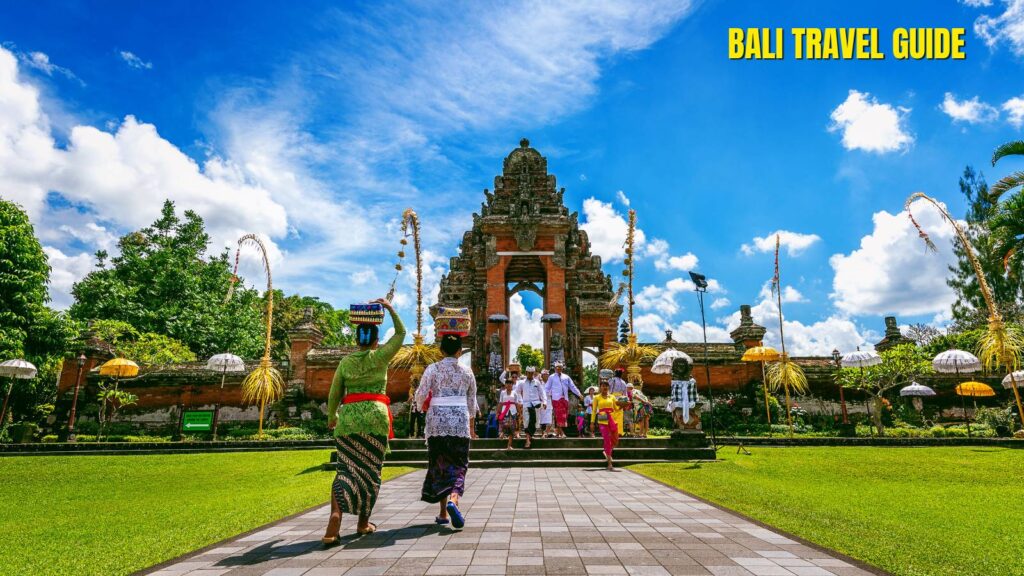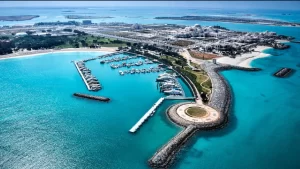Bali is often described as the Island of the Gods, a land of beaches, volcanoes, and vibrant nightlife. But what many travelers don’t realize is that beyond the crowded tourist zones, Bali hides a more mystical and authentic side.
Is Bali Safe for Solo Female Travelers? What I Wish I Knew
This Bali travel guide explores secret villages and hidden water temples that many tourists overlook. These places preserve Bali’s deep-rooted traditions, showcase its natural landscapes, and allow visitors to connect with the island’s spiritual essence. By venturing off the beaten path, travelers can see Bali as it truly is—untouched, sacred, and alive with culture.
Why Explore Bali’s Secret Villages and Hidden Temples?
Mainstream Bali tourism focuses on areas like Kuta, Ubud, and Seminyak, but these do not fully capture the island’s identity. Secret villages and hidden temples reveal Bali’s heritage in its purest form. Visiting them allows travelers to see ancient architecture, take part in sacred ceremonies, and meet communities that still practice age-old traditions.
Bali Holiday Packages: How to Reach, Best Time to Visit, Fees!
Unlike busy tourist hubs, these destinations offer peace, authenticity, and a sense of discovery. This is the side of Bali that feels timeless, where daily life is guided by rituals, the land is respected, and temples serve as living centers of faith. A complete Bali travel guide would be incomplete without highlighting these hidden treasures.
Best Time to Visit Bali’s Hidden Villages and Temples
The ideal time to explore Bali’s hidden villages and temples is during the dry season, between April and October, when the weather is clear and roads are easy to navigate. This is also the time when many cultural festivals take place, offering opportunities to witness unique ceremonies.
The wet season, from November to March, brings heavy rain, but the landscape becomes greener and villages are less crowded. For travelers interested in photography, early mornings and late afternoons provide the best natural light while avoiding peak tourist hours.
Top Secret Villages in Bali You Shouldn’t Miss
1. Tenganan Village: Ancient Bali Aga Traditions
Tenganan is one of the most historically significant villages in Bali. The Bali Aga, or original Balinese, live here and have preserved customs older than those found elsewhere on the island. The village is arranged with traditional homes lined up symmetrically, creating a sense of order and community.

What makes Tenganan special is its unique cultural expressions—particularly the famed double ikat weaving, a textile art that takes years to master. Few places in the world still practice this rare weaving technique, making it a cultural treasure.
Visitors can also witness traditional ceremonies like Mekare-kare, a ritual combat performance that honors ancestors. Exploring Tenganan feels like stepping into an open-air museum where every street and home reflects centuries of tradition.
2. Penglipuran Village: One of the World’s Cleanest Villages
Penglipuran is known internationally as one of the cleanest villages in the world. Walking through Penglipuran, travelers immediately notice the harmony of the village layout, with neat rows of homes and beautifully kept courtyards. The bamboo forest at the edge of the village adds a natural charm and demonstrates the community’s close relationship with the environment.
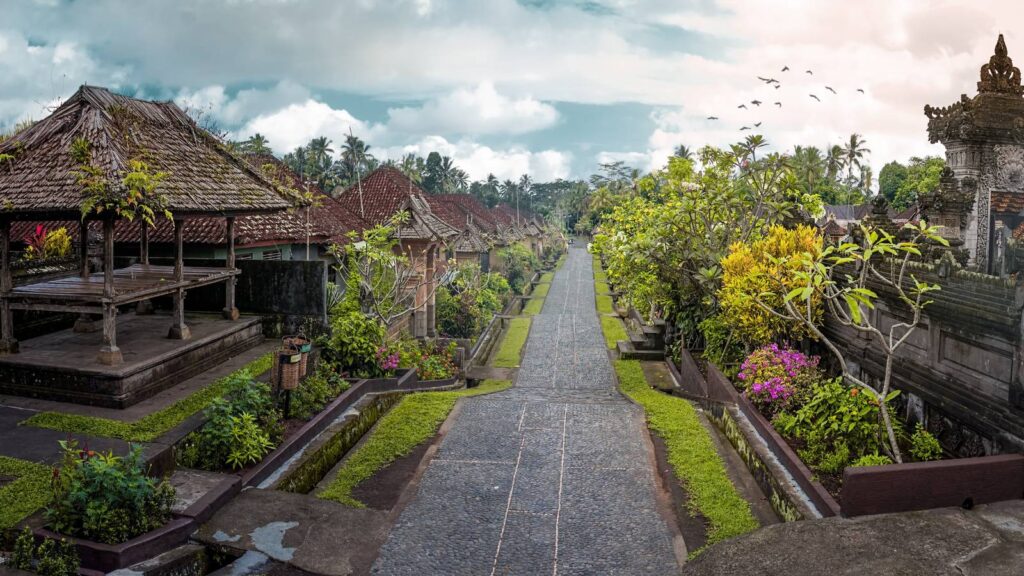
Penglipuran’s cleanliness and order are not just aesthetic choices but reflect deep respect for harmony, balance, and sustainability. Visitors can learn about local rules known as awig-awig, which guide behavior in the community and preserve its traditions.
A visit here offers not only beauty but also an understanding of how Balinese philosophy of balance between humans, nature, and spirituality shapes everyday life.
3. Sidemen Village: Untouched Rice Terraces and Tranquility
Sidemen, located in East Bali, remains one of the island’s most peaceful escapes. Unlike Ubud’s crowded rice terraces, Sidemen offers wide, unspoiled views of lush valleys and traditional farmlands. Farmers still plow their fields with buffalo, and families continue to live off the land as their ancestors did.
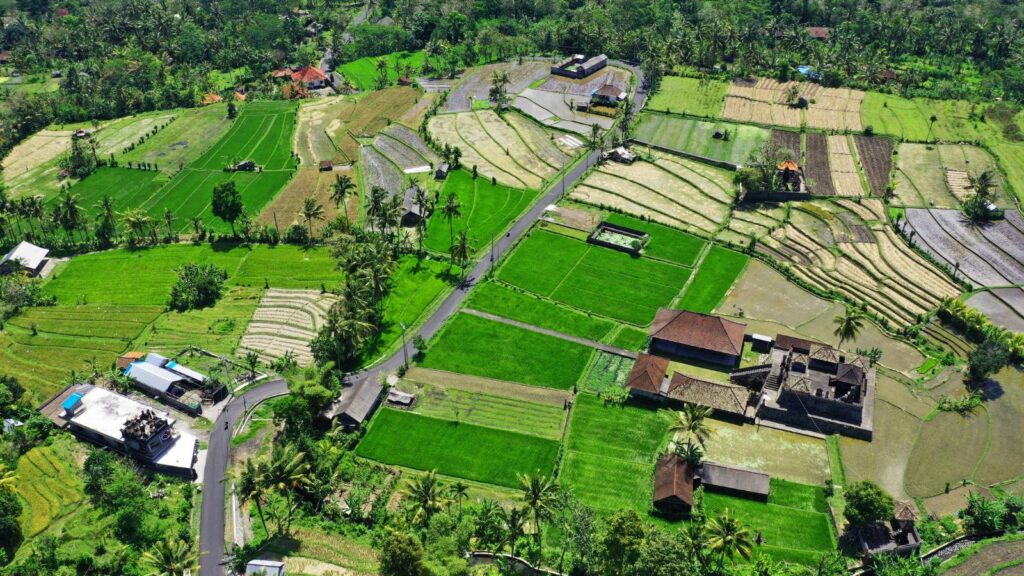
Sidemen is also home to artisans who produce songket, a handwoven textile decorated with gold and silver threads. For travelers, Sidemen provides opportunities to hike through rice fields, attend cooking classes, and stay in eco-lodges overlooking Mount Agung.
It is a place where one can slow down, breathe in fresh air, and experience the rhythm of Balinese rural life without modern interruptions.
Hidden Water Temples That Define Bali’s Spiritual Beauty
1. Tirta Empul: Sacred Purification Temple
Tirta Empul, near Tampaksiring, is one of Bali’s most sacred temples. The central feature of the temple is its holy spring, where water continuously flows into stone fountains. Locals and visitors alike participate in a purification ritual by bathing under these fountains, believing the water washes away negativity and restores balance.
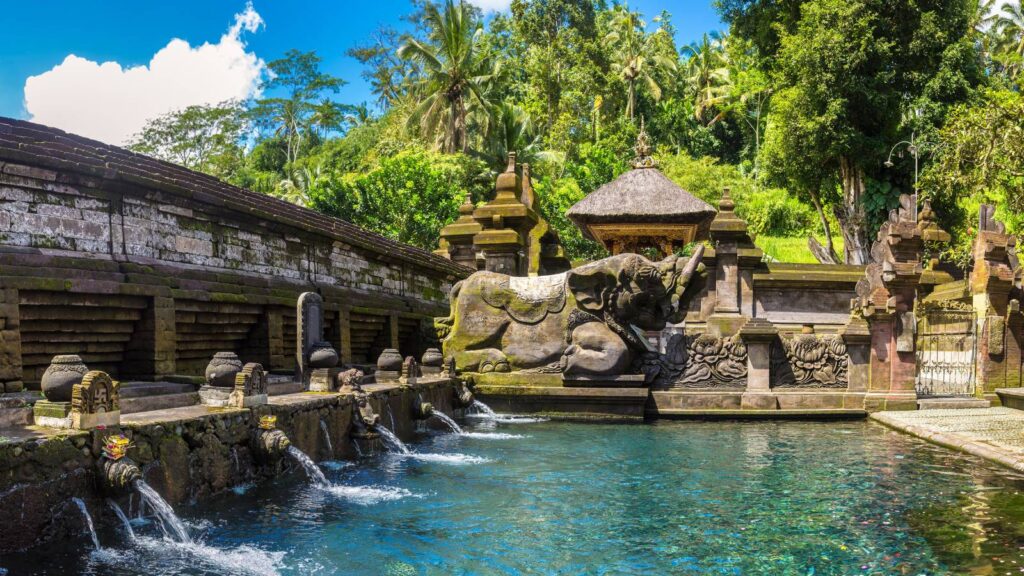
The temple complex itself is beautifully designed with shrines, courtyards, and sacred pools. The atmosphere is deeply spiritual, with the sound of water mingling with the scent of incense. A visit to Tirta Empul is not just about sightseeing but also about connecting with Balinese spirituality in a very personal way.
2. Goa Gajah (Elephant Cave): Mystical Heritage Site
Goa Gajah, also called Elephant Cave, is both a temple and an archaeological wonder. Dating back to the 9th century, the site has elements of Hindu and Buddhist traditions. The cave entrance, with its menacing face carved into stone, is one of Bali’s most iconic images.
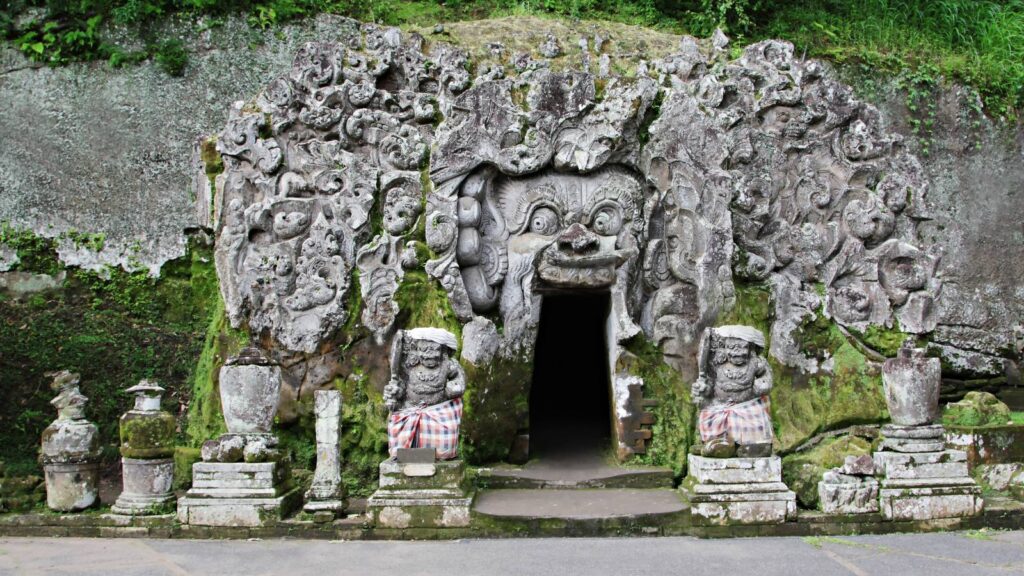
Inside the cave are meditation chambers once used by priests and monks. Outside, visitors find bathing pools, fountains, and relics that speak to Bali’s ancient past. Exploring Goa Gajah is not just about seeing carvings—it is about stepping into a site where history, religion, and art merge into one mystical experience.
3. Pura Gunung Kawi: Ancient Shrines Carved in Stone
Pura Gunung Kawi is located in a lush river valley near Tampaksiring. It is famous for its massive shrines carved into rock cliffs, believed to be dedicated to ancient Balinese royalty. The temple is surrounded by rice terraces, tropical vegetation, and flowing water, creating a tranquil and sacred environment.
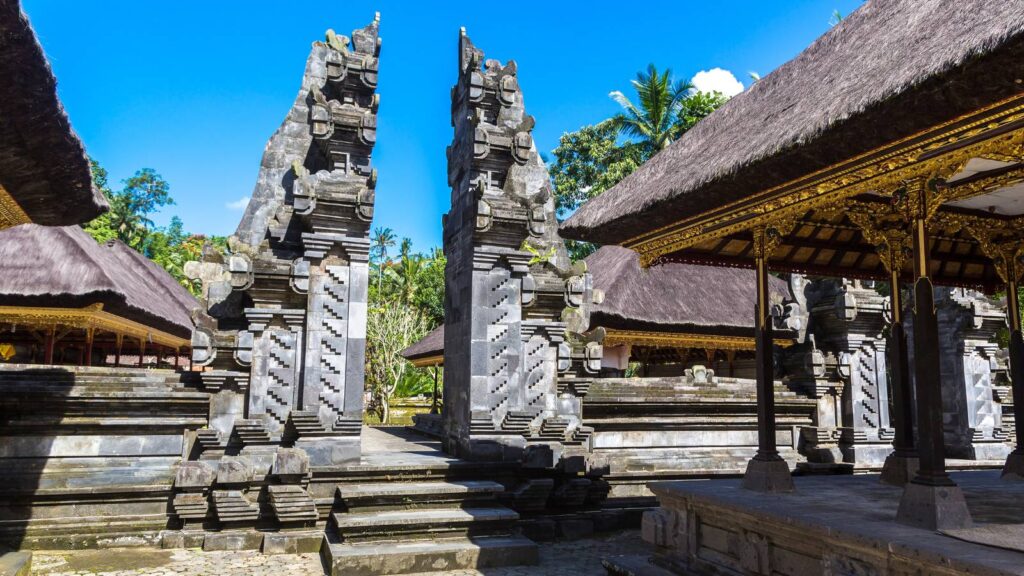
Reaching the temple involves descending hundreds of steps, but the journey itself is part of the experience. Visitors are rewarded with breathtaking views and a deep sense of history. This temple is one of the most impressive examples of Bali’s ability to harmonize architecture with nature.
How to Reach These Hidden Places: Travel Routes and Transport Tips
Many of these villages and temples are located outside of Bali’s main tourist areas. Renting a scooter is a popular option for confident riders, but for longer journeys, hiring a private driver is more practical and comfortable.
Guided tours are also widely available, often including cultural explanations and access to places tourists might miss on their own. Roads to remote villages can be narrow and winding, so patience and careful driving are essential. Visitors should also keep cash handy, as rural areas often lack ATMs and credit card facilities.
Where to Stay Near Bali’s Secret Villages and Temples
Travelers looking to spend more time in these areas will find a variety of accommodations. Sidemen offers eco-lodges and boutique resorts nestled among rice terraces, providing both comfort and natural beauty.
In Tenganan, homestays allow visitors to live alongside local families, giving them firsthand experience of village life. Around Ubud, boutique hotels offer easy access to temples like Tirta Empul and Gunung Kawi. Staying close to these hidden gems not only enriches the experience but also supports local communities through sustainable tourism.
Local Food and Authentic Balinese Cuisine to Try
Exploring hidden villages is also a culinary journey. Local warungs serve traditional dishes prepared with fresh, homegrown ingredients. Visitors can try specialties such as lawar (spiced meat and vegetable mix), babi guling (suckling pig), and sate lilit (spiced minced meat satay).
In Sidemen, travelers can enjoy meals made with organic produce from nearby farms, while Penglipuran is known for herbal drinks made from bamboo shoots and roots. Food in these villages is not only delicious but also deeply connected to the land and culture.
Essential Travel Tips for Exploring Bali Off the Beaten Path
Traveling to hidden parts of Bali requires preparation. Comfortable walking shoes are necessary for temple visits that involve many steps. Modest clothing is essential, especially when entering sacred spaces.
Learning simple Balinese phrases such as om swastiastu (a greeting) or suksma (thank you) creates a friendly connection with locals. Travelers should also be mindful about photography, always asking before capturing sacred ceremonies or portraits. Carrying a small first-aid kit and basic travel supplies is also wise when exploring rural areas.
FAQs
1. How many days should I plan for hidden village tours?
A stay of at least 3–5 days allows travelers to explore villages like Tenganan, Penglipuran, and Sidemen, along with temples such as Tirta Empul and Gunung Kawi.
2. Are these temples open to tourists?
Yes, temples like Tirta Empul, Goa Gajah, and Gunung Kawi are open to visitors, though respectful dress codes must be followed.
3. What is the entry fee for Tirta Empul and Gunung Kawi?
Entry fees range between 30,000 and 50,000 IDR (approximately $2–3 USD), making them affordable for all travelers.
4. Is it safe to travel alone in Bali’s secret villages?
Yes, these areas are safe, though solo travelers should arrange reliable transport and inform their hosts of their plans.
5. Can I swim in the sacred water temples?
Swimming is not allowed, but purification bathing rituals are open to visitors at temples like Tirta Empul.
6. What should I wear when visiting temples?
Visitors must wear sarongs and temple sashes, which are usually available at the entrance for rent or included in the entry fee.
7. How do I respect local customs in villages?
Travelers should avoid interrupting ceremonies, ask before taking photographs, and show appreciation for local traditions.
8. Are guided tours better than exploring alone?
Guided tours provide cultural explanations and easier access, while solo exploration offers freedom. Many travelers combine both approaches.
9. Can I stay overnight in these villages?
Yes, many hidden villages such as Sidemen and Tenganan offer homestays and eco-lodges that welcome overnight guests.
10. What makes this Bali travel guide unique?
This Bali travel guide highlights hidden destinations, focusing on cultural immersion, spiritual discovery, and sustainable tourism, unlike mainstream itineraries that emphasize beaches and nightlife.
